11.8: Sponges
- Page ID
- 1389
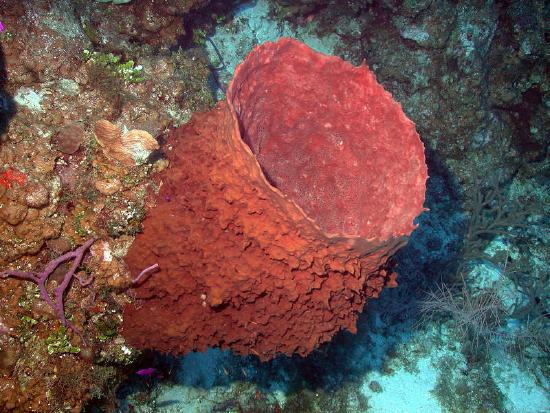
So what exactly is a sponge?
Here we have a giant barrel sponge. How can something that looks like that be considered an animal? Where's the head? Where are the legs? Where's the mouth?
Sponges
Invertebrates are animals without a backbone. They are the most numerous animals on Earth. Most invertebrates are insects. However, simpler invertebrates evolved before insects. Some, like the sponges you will read about in this concept, have existed virtually unchanged for hundreds of millions of years. Their continued existence is evidence that they are well adapted for their habitats. They also evolved some of the most important traits that are found in almost all animals today. Without the traits that evolved in sponges and other simple invertebrates, you would not exist. Sponges are aquatic invertebrates that make up the phylum Porifera. The word "porifera" means pore-bearing. The phylum is aptly named. As you can see from Figure below, a sponge has a porous body. There are at least 5,000 living species of sponges. Almost all of them inhabit the ocean, living mainly on coral reefs or the ocean floor.
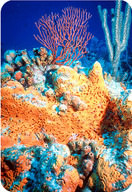 Sponge on a Coral Reef. This orange sponge is covered with pores. Can you predict the function of the pores?
Sponge on a Coral Reef. This orange sponge is covered with pores. Can you predict the function of the pores?Structure and Function of Sponges
Sponges come in a variety of shapes and sizes. For example, they may be shaped like tubes, fans, cones, or just blobs. They range in diameter from about a centimeter (0.4 inches) to over a meter (3.3 feet). Many species live in colonies that may be quite large. Adult sponges are sessile. This means they are unable to move from place to place. Root-like projections anchor them to solid surfaces such as rocks and reefs.
Sponges have an internal skeleton that gives them support and protection. An internal skeleton is called an endoskeleton. A sponge endoskeleton consists of short, sharp rods called spicules (see Figure below). Spicules are made of silica, calcium carbonate, or spongin, a tough protein. They grow from specialized cells in the body of the sponge.
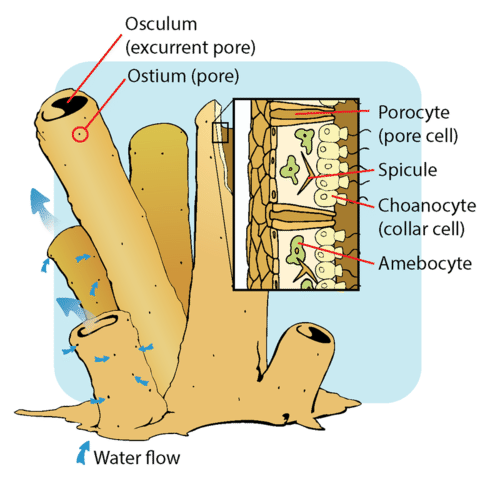 Sponge Anatomy. A sponge lacks tissues and organs, but it has several types of specialized cells.
Sponge Anatomy. A sponge lacks tissues and organs, but it has several types of specialized cells.Sponges are filter feeders. They pump water into their body through their pores. The water flows through a large central cavity called the spongocoel (see Figure above). As the water flows by, specialized collar cells (which are also known as choanocytes) filter out food particles such as bacteria. Collar cells have tiny hairs that trap the particles. They also have a flagellum that whips the water and keeps it moving. Once the food is trapped, the collar cells digest it (see Figure below). Cells called amebocytes also help digest the food. They distribute the nutrients to the rest of the body as well. Finally, the water flows back out of the body through an opening called the osculum. As water flows through the sponge, oxygen diffuses from the water to the sponge’s cells. The cells also expel wastes into the water for removal through the osculum.
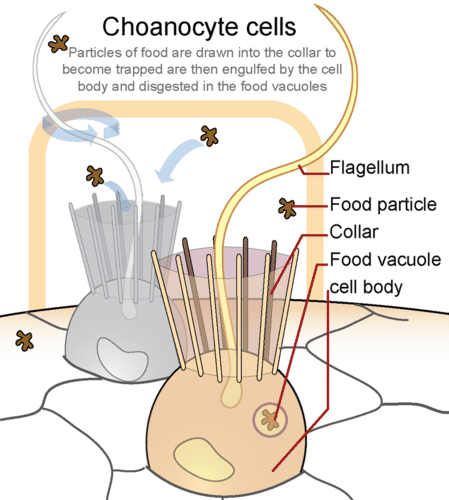 Collar Cell. The collar cells of sponges trap and digest food.
Collar Cell. The collar cells of sponges trap and digest food.Sponge Reproduction
Sponges reproduce both asexually and sexually. Asexual reproduction occurs by budding. Figure below shows the sponge life cycle when sexual reproduction is involved. Adult sponges produce eggs and sperm. In many species, the same individuals produce both. However, they don’t produce eggs and sperm at the same time. As a result, self-fertilization is unlikely to occur. What is an advantage of avoiding self-fertilization?
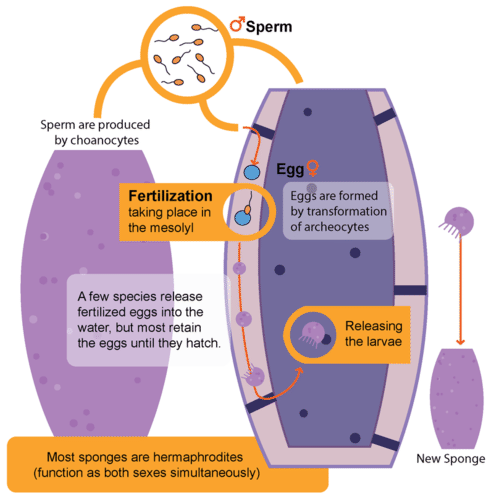 The sponge life cycle includes sexual reproduction. Sponges may also reproduce asexually.
The sponge life cycle includes sexual reproduction. Sponges may also reproduce asexually.Sperm are released into the surrounding water through the osculum. If they enter a female sponge through a pore, they may be trapped by collar cells. Trapped sperm are delivered to eggs inside the female body, where fertilization takes place. The resulting zygote develops into a larva. Unlike the adult, the larva is motile. It is covered with cilia that propel it through the water. As the larva grows, it becomes more similar to an adult sponge and loses its ability to swim.
Ecology of Sponges
Sponges that live on coral reefs have symbiotic relationships with other reef species. They provide shelter for algae, shrimp, and crabs. In return, they get nutrients from the metabolism of the organisms they shelter. Sponges are a source of food for many species of fish. Because sponges are sessile, they cannot flee from predators. Their sharp spicules provide some defense. They also produce toxins that may poison predators that try to eat them.
Summary
- Sponges are aquatic invertebrates. They make up the phylum Porifera.
- Sponges have specialized cells and an endoskeleton.
- Sponges lack tissues and body symmetry.
- Adult sponges are sessile filter feeders.
- Sponge larvae have cilia for swimming.
Review
- Define sessile. Name an invertebrate with a sessile adult stage.
- Describe the skeleton of a sponge.
- Sponges have specialized cells called collar cells. Describe how collar cells are specialized for the functions they serve.
- Create a diagram of an adult sponge body plan that shows how sponges obtain food.
| Image | Reference | Attributions |
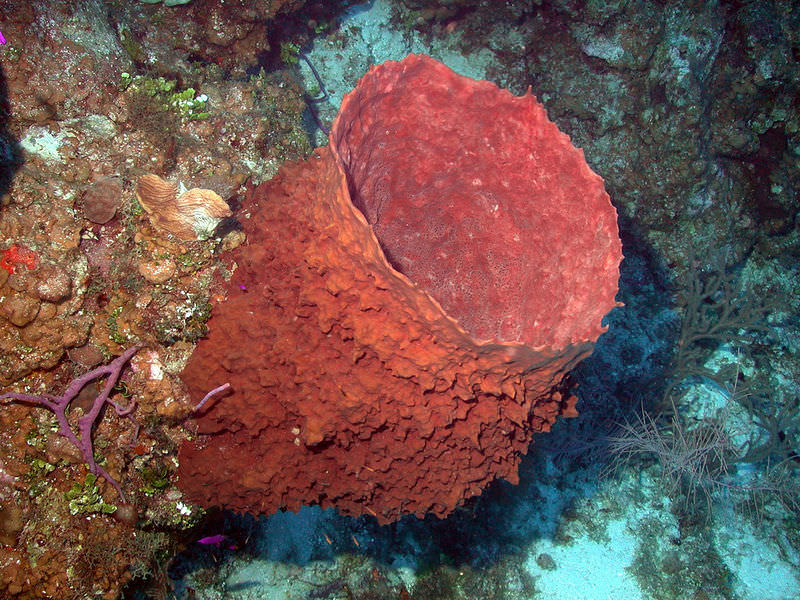 |
[Figure 1] | Credit: Mariana Ruiz Villarreal (LadyofHats) for CK-12 Foundation Source: CK-12 Foundation License: Public Domain; CC BY-NC 3.0 |
 |
[Figure 2] | Credit: Courtesy of US National Oceanic and Atmospheric Administration Source: commons.wikimedia.org/wiki/File:Elephant-ear-sponge.jpg License: Public Domain |
 |
[Figure 3] | Credit: Mariana Ruiz Villarreal (LadyofHats) for CK-12 Foundation Source: CK-12 Foundation License: CC BY-NC 3.0 |
 |
[Figure 4] | Credit: Mariana Ruiz Villarreal (LadyofHats) for CK-12 Foundation Source: CK-12 Foundation License: CC BY-NC 3.0 |
 |
[Figure 5] | Credit: Mariana Ruiz Villarreal (LadyofHats) for CK-12 Foundation Source: CK-12 Foundation License: CC BY-NC 3.0 |

